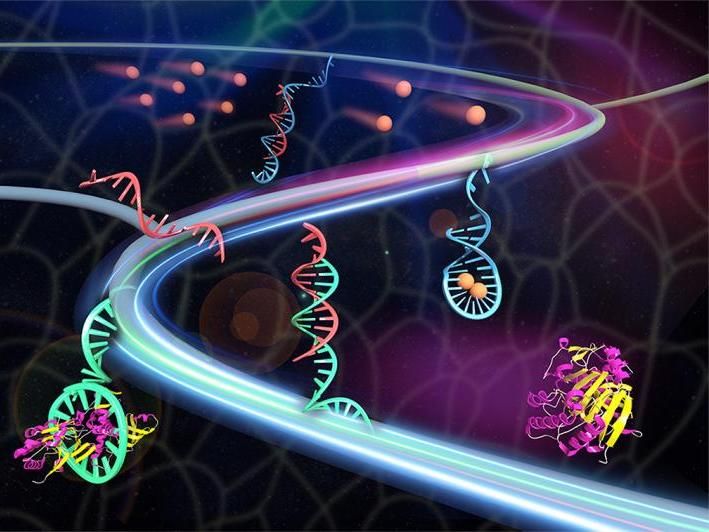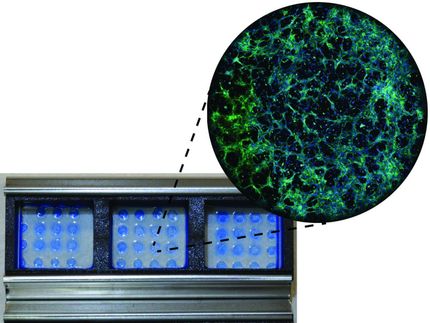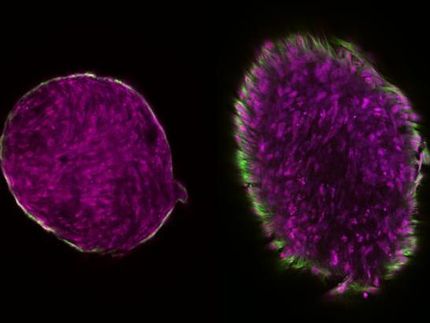Mimicking biological process, hydrogel signals and releases proteins
An artificial system using a DNA-laced hydrogel can receive a chemical signal and release the appropriate protein, according to Penn State researchers. Further stimulation by the chemical signal continues to trigger a response.

A synthetic tissue releases therapeutic proteins (maroon/yellow) once triggered by metabolites (sandy brown). The metabolites contact with the double-stranded DNA (red/blue) to release the red triggering DNA. The triggering DNA activates the aptamer(cyan)-protein complex to release the protein.
Xin Zou/Jinping Lai (Penn State)
A hydrogel is a network of polymer chains that attract water and can be used to simulate biological tissue.
Many systems in cells and in the human body are set up with a signal and response pathway. One of the best known is that of glucose, a small sugar that triggers the release of insulin.
We've only done this recently in a petri dish," said Yong Wang, professor of biomedical engineering. "We did tests using smooth muscle cells, but we would of course like to do this in a living animal."
"With rational design, this biomimetic hydrogel system would constitute a general platform of controlling the output of signaling proteins for versatile potential applications such as drug delivery, cell regulation, molecular sensing and regenerative medicine."
The hydrogel, made of polyethylene glycol, is infused with two different types of DNA. One is an aptamer -- a short strand of DNA that attaches to the chemical the researchers want to release into the cell. In the case of glucose and insulin, the aptamer would bind with insulin the "drug" the researchers want to release. The other type is a double-stranded helical molecule of DNA chosen to react with the metabolite signal -- glucose -- and initiate the chemical release.
When the signaling molecule reaches a double strand of DNA, the DNA separates into two strands. One strand binds with the molecule and the other moves toward the aptamer and forces it to release the protein bound to it. The protein can then move through the cells to its normal binding site and perform its normal actions.
"This was not a simple process to create," said Wang. "One graduate student worked on it for three years before giving up. In total, it took four to five years to get this far." The researchers used adenosine as the signaling chemical and platelet-derived growth factor as the signaling protein to be released. The system can repeat the sequence, releasing signaling proteins until there are no more to release.
"We don't yet know how to easily replenish the proteins," said Wang.
The researchers tested the adenosine-PDGF-BB hydrogel system and found that without a signal chemical, the amount of signaling protein released by the hydrogel was very small. When the signal chemical -- adenosine -- was applied, the hydrogel released about 28 percent of the target signaling protein -- PDGF-BB. Other chemicals similar to adenosine, like guanosine and uridine did not cause the release of PDGF-BB from the hydrogel.
"Eventually we would like to use this system for controlled drug delivery and other biological actions," said Wang.)
Original publication
Original publication
Lai, Jinping and Li, Shihui and Shi, Xuechen and Coyne, James and Zhao, Nan and Dong, Fengping and Mao, Yingwei and Wang, Yong; "Displacement and hybridization reactions in aptamer-functionalized hydrogels for biomimetic protein release and signal transduction"; Chem. Sci.; 2017
Topics
Organizations
Other news from the department science

Get the life science industry in your inbox
By submitting this form you agree that LUMITOS AG will send you the newsletter(s) selected above by email. Your data will not be passed on to third parties. Your data will be stored and processed in accordance with our data protection regulations. LUMITOS may contact you by email for the purpose of advertising or market and opinion surveys. You can revoke your consent at any time without giving reasons to LUMITOS AG, Ernst-Augustin-Str. 2, 12489 Berlin, Germany or by e-mail at revoke@lumitos.com with effect for the future. In addition, each email contains a link to unsubscribe from the corresponding newsletter.
More news from our other portals
Last viewed contents
GE Healthcare to acquire PAA Laboratories GmbH
Precursor Cells Generated From Human Embryonic Stem Cells Show Ability to Repair Vascular Damage in Animals - New, scalable population of hemangioblast cells halves the death rate following heart attack and repairs ischemic limbs and damaged vasculature























































